elizabeth., large in place of medium, typical instead of lower), we extracted the benefits to the better compare (i.elizabeth., large as opposed to reduced). When a study consisted of several feeling systems all over day, i removed the info regarding longest pursue-up period. When the a survey made use of statistical control inside figuring an effect proportions, i extracted the info in the model with the fewest mathematical controls to continue to be because consistent you could all over knowledge (therefore we filed the kind and number of covariates made use of inside for every single data to run blog post hoc relative analyses). We coded the research structure utilized rather than estimate threat of individual research bias. This new coding method is available regarding the article writers.
Most recommendations taken from the studies are extracted verbatim regarding the records. Thus, the newest inter-rater arrangement is high to possess categorical variables (indicate Cohen’s kappa = 0.73, SD = 0.13) as well as for persisted details (suggest intraclass relationship = 0.80, SD = .14). Discrepancies across the coding sets were resolved thanks to subsequent analysis of your manuscript up to consensus was acquired.
Aggregate impression brands was basically computed having fun with random outcomes patterns adopting the confirmation away from heterogeneity. A random effects approach produces show you to definitely generalize outside of the try out-of training indeed analyzed . The fresh assumptions built in so it meta-data clearly warrant this process: The fact particular details serve as moderators of your own observed relationship between social dating and you may mortality means that the studies analyzed commonly imagine various other society impact versions. Random consequences designs need such as anywhere between-knowledge variation under consideration, while fixed outcomes activities don’t . In for every single data conducted, i examined the rest difference to ensure one random outcomes activities was compatible.
Results
Statistically nonredundant impact products was basically extracted from 148 knowledge (–; pick Desk 1). Study were advertised of 308,849 players, having 51% off North america, 37% out of Europe, 11% out of Asia, and you may step one% away from Australian continent. Across the all the knowledge, the typical age of people in the initial analysis are 63.9 many years, and you will participants were evenly portrayed across the intercourse (49% ladies, 51% male). Of your training looked at, 60% on it neighborhood products, but twenty-four% checked out individuals acquiring outpatient hospital treatment, and you can 16% utilized people when you look at the inpatient scientific configurations. Out of education of people which have an effective pre-present medical diagnosis, 44% was basically specific so you’re able to heart problems (CVD), 36% to help you cancer tumors, 9% so you can kidney condition, plus the remaining 11% had numerous requirements together with neurological condition. Search accounts usually (81%) felt every-cause mortality, however minimal reviews so you’re able to death of cancer (9%), CVD (8%), or other explanations (2%). Players was basically adopted to have on average seven.5 years (SD = 7.step one, assortment = 90 days to 58 many years), which have an average of 31% of your professionals passing away within this per study’s go after-up several months.
Omnibus Investigation
Across 148 studies, the random effects weighted average effect size was OR = 1.50 (95% confidence interval [CI] = 1.42 to 1.59), which indicated a 50% increased likelihood of survival as a function of stronger social relations. Odds ratios ranged from 0.77 to 6.50, with substantial heterogeneity across studies (I 2 = 81% [95% CI = 78% to 84%]; Q(147) = 790, p<0.001; ? 2 = 0.07), suggesting that systematic effect size variability was unaccounted for. Thus factors associated with the studies themselves (e.g., publication status), participant characteristics (e.g., age, health status), and the type of evaluation of social relationships (e.g., structural social networks versus perceptions of functional social support) may have moderated the overall results. We therefore conducted additional analyses to determine the extent to which these variables moderated the overall results.
To evaluate the possibility of book bias , i conducted several analyses. Very first, i determined new falter-safe N to-be cuatro,274, the theoretic amount of unpublished studies having feeling versions averaging no (no perception) that would be necessary to give negligible the fresh new omnibus efficiency. 2nd, we operating brand new “skinny and fill” methods revealed of the Duval and Tweedie , in order to guess what number of studies lost because of book bias, however, it analysis did not inform you people degree who does you need are written into the other side of your distribution, and therefore modifications into omnibus impression size are too many. 3rd, i calculated one another Egger’s regression make sure the opposite to this take to needed by Peters and you can colleagues that is best suitable for study when you look at the lnOR format. The results off each other analyses didn’t arrive at mathematical benefits (p>0.05). In the end, we plotted a contour-increased funnel plot (Contour 2) . The information and knowledge taken from it meta-study was in fact pretty symmetric with regards to their own imply; less than ten degree was in fact “missing” into the remaining section of the shipments that would made the newest patch shaped. Centered on these types of numerous analyses, book bias is impractical to help you jeopardize the results.








